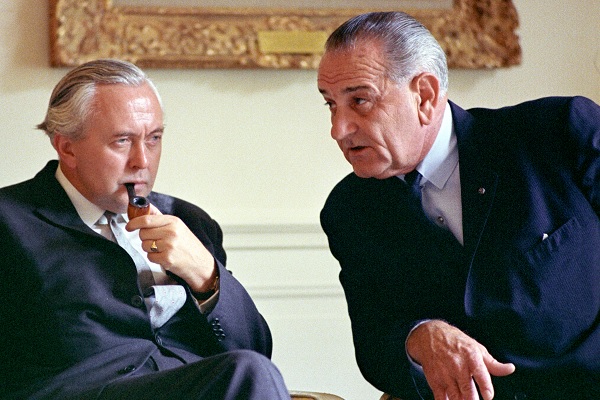
–>
July 17, 2022
The United States in the 1950s transformed into a non-constitutional form of government, where federal departments collectively hold more authority than elected officials. The transformation broadened in the 1960s and leveled off during the 1990s. The ability to transition back to three branches of government as defined in the U.S. Constitution is the intent of the growing citizen majority today. The increasing friction among all involved parties for restoring the constitutional form of government is heating to a flashpoint by way of strife.
‘); googletag.cmd.push(function () { googletag.display(‘div-gpt-ad-1609268089992-0’); }); }
Dwight Eisenhower cautioned against this transformation during his farewell speech with his warning of the military-industrial complex growing beyond manageability. The U.K. prime minister’s selection process is a close example of the identified U.S. government transformation. The U.K. people vote for a party to be in the majority, then the elected party members select a prime minister. The U.K. P.M. is selected by party members instead of elected directly by the people. The U.S. moved to operate government a jubilee ago by selected federal department members instead of elected federal officials for many roles in all federal departments. Congress outsourced its work, and now it cannot regain control of its work to fulfill its responsibilities. Any part of the Legislative Branch ceasing to fund any federal department results in the Executive Branch redirecting funds from unaffected departments to continue operations of the de-funded department segment. The inability of the federal Legislative Branch to hold a federal department or worker accountable today is conclusive proof of this assertion.
John Kennedy won the 1960 presidency by an overwhelming majority. Lyndon Johnson won the 1960 presidency by an even more overwhelming majority. He continued the Kennedy policy visions by undertaking the Great Society (G.S.) initiative. The initiative caused Johnson not to run for re-election in 1968. The G.S. was viewed as impossible due to race riots and federal budget choices. The Vietnam events contrasted with the G.S.’s vision. Concisely, the 1968 voting populaces proved that the G.S. was for some but not all, causing oppression by the some on the rest of society through elitism. The tangible to this reasoning was that the G.S. violated the Equal Protection Clause of the U.S. Constitution. The G.S.’s vision failed by concept and design to accomplish its necessary structures through its proposed funding.
The arrival at societal and political conditions seen today are clear outcomes based on the election history of the House of Representatives and the Senate. The voting trend pattern shows voter dissatisfaction with the G.S.’s vision matched with the change of election power between parties.
‘); googletag.cmd.push(function () { googletag.display(‘div-gpt-ad-1609270365559-0’); }); }
The events of the late 1960s are playing out again today in the U.S. Successive budget approvals for the past 40 years show concisely the inability to operate the federal government by purposed-based funding alone but also by adding unrelated funding efforts to approved budgets. Things as a whole are far out of control for the U.S. at many societal point structures. There is little interest abroad for the U.S. to take any time to regain its governmental footing.
Ronald Reagan moved to out-build and subsequently defeat the Soviet Union in the Cold War by the latter’s inability to keep up with defense production. It worked. The Cold War never went hot. We now see the desire of Russia to surge back to the Soviet Union days of greatness by their invasion of Ukraine. The same logic could play out again many times, where one country decides to return to its olden days and force the global economic community into chaos. The G.S.’s vision is then seen by those suffering economic turmoil as not only impossible to accomplish, but also as enabling the turmoil to occur.
The answer for the U.S. to get out of the form of government in power since the 1950s is simple. The states must fix the problem. The federal government has neither the ability nor the interest to fix the federal government.
Look to U.S. governors for the path forward to resolve this problem. The Republican Governors Association launched in April 2022 what they call The American Governors’ Border Strike Force (AGBSF) to unify their intentions. The effort is to resolve what they identified as both disastrous and dangerous. Twenty-six out of 28 signed the agreement. Charlie Baker (Mass.) and Phil Scott (Vt.) did not sign. Twenty-six governors out of 50 states is 52% of the country. The two out of 28 who did not sign equates to only 7%. No governor is going to sign any cross-state initiative and take subsequent matching action without already holding widespread support from his constituents. The majority of America is with these 26 governors. There is no dissembling occurring within these states of both their statehood and collective intent to repair the breach of U.S. governance that is under their control to rectify.
There are four pressing items that are not clear now but will soon play out before our eyes. First, where is the flashpoint? There will be an ultimatum between the AGBSF and the federal government contesting the Supremacy Clause of the U.S. Constitution. Second, will the states of the signed governors continue to back the effort once the ultimatum is issued and acted on by the federal government? Probable, but not certain at this point. Third, will the AGBSF hold together after the federal response? This answer is defined largely by support from countries abroad who side with either the states or the federal. Finally, will the federal Legislative Branch take back control from the federal departments after the acted on ultimatum occurs? This item is the biggest place where the conceptual meets the tangible for state and federal views of the U.S. Constitution to rub together.
It is doubtful the constituents today will care as much about the federal view going forward. Their pain experienced from changes in how public schools are operated, federal distribution of funds to political pandering instead of federal budgeting without partiality, and the consistent immigration increase to the U.S. occurring over the past two to three decades all occur in concert. It is unclear what is next for this dissatisfied group. There is no indication this pushing back will stop, slow, or remain narrow in focus. There is abundant evidence that the pushing back will grow in pressure, accelerate, and broaden in scope.
‘); googletag.cmd.push(function () { googletag.display(‘div-gpt-ad-1609268078422-0’); }); } if (publir_show_ads) { document.write(“
Humanity has a way of working things out in a civilized manner. The civility tendency tends to occur after pushing one another around for a long time. Push is coming to strife in America. Sufficient trust of elected officials at the federal level by constituents is running out of proverbial gas on both sides of the political equation. The used-up trust given by followers is not being replaced in leaders due to long-term patterns of poor and toxic leadership, not only recent events.
Stephen Dawson is an executive consultant of technology and business strategy, serving significant international organizations by providing leadership consulting, strategic planning, and executive communications. Contact him at [email protected].

<!– if(page_width_onload <= 479) { document.write("
“); googletag.cmd.push(function() { googletag.display(‘div-gpt-ad-1345489840937-4’); }); } –> If you experience technical problems, please write to [email protected]
FOLLOW US ON
<!–
–>
<!– _qoptions={ qacct:”p-9bKF-NgTuSFM6″ }; ![]() –> <!—-> <!– var addthis_share = { email_template: “new_template” } –>
–> <!—-> <!– var addthis_share = { email_template: “new_template” } –>





